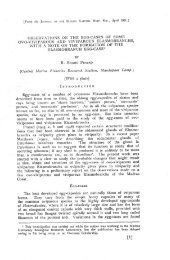PDF - Eprints@CMFRI
PDF - Eprints@CMFRI
PDF - Eprints@CMFRI
Create successful ePaper yourself
Turn your PDF publications into a flip-book with our unique Google optimized e-Paper software.
144<br />
rows or separated by transverse partitions of the valleys. Septa continuous over collines, septal margines<br />
coarsely toothed .<br />
Madrepora<br />
Mer-ulina<br />
ampliota<br />
ampliata<br />
sp. no".<br />
Merulina ef ampliata (ELLIS and SOLANDER), 1786<br />
(Plate H . Figs. 3- 5)<br />
1786. ELLIS & SOLANDER. 157; pI. 41 / 1. 2.<br />
1797. ES PER . 98; pI. 77/1 - 3.<br />
IS34. EHRENBERG. 238.<br />
1846. DANA, 272; pIs. 15/ 1, la- t, 2. 220 ; 16/ 1.<br />
1925. MA ITHA!. 127 ; pis. 1/4-6; 13/ 1- 8 ; 59/l. 4 ; 67/ 3 (synonymy).<br />
1952. CROSSLAND, 151.<br />
1975. CHEVALIER. 20S ; pis. IS/ 2- 5; 19/1 ; 20/ 1--4; 41 / 11.<br />
1976. PI LLAI & SCHEER. 64.<br />
1980. VERON & PICHON. 216 ; figs. 358- 314; 764.<br />
1980. HEAD. ISl , 463; pI. IV- 2a, b. 3.<br />
EHRENBERG 's M. ampliata (1834 : 328) in the Museum in Berlin is from an unknown locality. KLUN·<br />
ZINGER (1879) and MARENZELLER (1906) have not found this species. First MATTHAI (1928) repons<br />
on one specimen from Red Sea but without giving details. CROSSLA D (1952) also mentions one specimen<br />
from Red Sea (the same as MATTHAI ?), " in the orth a small scrap, probably semi-fossil". Therefore<br />
CHEVALIER (1975) writes " Inconnue en Mer Rouge". But VERON & PICHON ( 1980) state again Red<br />
Sea in their "Distribution" of the species.<br />
HAED (1980) figures for the first time specimens of a Mernlina from the Red Sea. But he asseigns it<br />
to a new species, because it differs from M. ampliata in having broader collines, wider valleys and, especially<br />
in flat portions of the corallum, isolated calices.<br />
The same characters we have found on specimens from Sanganeb Reef, which we received from Prof.<br />
J . SCHROEDER , Port Sudan. The most conspicuous feature are the calices in explanate parts of the corallum,<br />
which are separated from each other in the valleys by broad transverse partitions rising to level of collines.<br />
Only at the periphery of the corallum the valleys are continuous.<br />
MATTHAI (I928: 132) has described a similar specimen with single and some "distomodaeal" corallites<br />
from Sumatra under his M. ampliata. We also group our specimens provisionally to M. ampliata.<br />
Material:<br />
Gulf of Aqaba: Jerus. SLR 1191 (Marsa el Muqeibla).<br />
Central R. S.: P. Sud . Sa 56 , 63 (Sanganeb R.).<br />
Dis t rib uti 0 n: Red Sea and Western Indian Ocean to Tonga and Samoa in the Pacific.<br />
Remark s: HEAD (1980) wrote that a full account of his new species is in preparation. In the<br />
meantime this acco unt is in press. He has named his species M. seheeri.<br />
Family Mussidae ORTMANN , 1890<br />
Synopsis of the genera of Mussidae from Red Sea:<br />
1. Corallum solitary. Septa exsert, arched and swollen at the theca. Only the lower outer part of the<br />
major septa has teeth ........ . ...... .. ... .. .... .. ........ . .. . .. . .... .. .. . . .. ()marina<br />
2. Corallum tufted, ramose, phaceloid . Corallites 10 to 25 mm in diameter, monostomodaeal or in short<br />
or longer valleys. Septa thickened .. .... .. . . . . ......... . .... . .... . . . .. . .... . . Lobophyllia<br />
3. Corallum massive, plocoid . Corallites 10 mm and more. Mono- to tristomodaeal. . .. .. Aeanthastrea<br />
4. Corallum branching, phaceloid or encrusting, cerioid. Corallites 4 to 13 mm. Septa typically mussid<br />
in two or three cycles. . .... . ....... . ....... .. ... ... .. . ... . ............... Blastomussa<br />
Genus Cjmarina BRUEGGEMANN , 1877<br />
Type species : Cynarina savignyi BRUEGGEMANN, 1877.
















